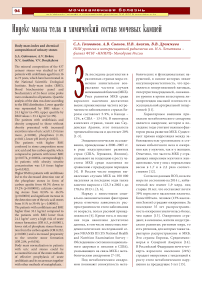Индекс массы тела и химический состав мочевых камней
Автор: Голованов С.А., Сивков А.В., Анохин Н.В., Дрожжева В.В.
Журнал: Экспериментальная и клиническая урология @ecuro
Рубрика: Мочекаменная болезнь
Статья в выпуске: 4, 2015 года.
Бесплатный доступ
Исследован минеральный состав 437 мочевых конкрементов от 437 больных мочекаменной болезнью (МКБ) в возрасте от 16 до 75 лет, проходивших обследование и лечение в клинике НИИ урологии Минздрава России. У всех пациентов определяли Индекс массы тела (ИМТ) и биохимические показатели крови и суточной экскреции мочи. Был проведен квартальный анализ данных по величине значений ИМТ. Нижний квартиль распределения был представлен случаями (n=99) со значениями ИМТ (2), а верхний квартиль случаями (n=99) со значениями ИМТ (>33,1 кг/м2). Больные уролитиазом, страдающие ожирением, отличались от больных с низкими значениями ИМТ повышенной суточной экскрецией мочевой кислоты (в 1,15 раза, р2 по сравнению с пациентами с ИМТ менее 24,1 кг/м2 имеют очень высокий риск формирования уратных камней (показатель отношения шансов (OR) 6,5, р
Метаболический синдром, ожирение, индекс массы тела, мочекаменная болезнь, метаболические типы мочекаменной болезни, отношение шансов, риск формирования мочевых камней
Короткий адрес: https://sciup.org/142188076
IDR: 142188076
Текст научной статьи Индекс массы тела и химический состав мочевых камней
The mineral composition of the 437 urinary stones was studied in 437 patients with urolithiasis aged from 16 to 75 years, which have been treated in the National Scientific Urological Institute. Body-mass index (BMI), blood biochemistry panel and biochemistry of 24-hour urine probe were evaluated in all patients. Quartile analysis of the data was done according to the BMI distribution. Lower quartile was represented by BMI values < 24.1 kg/m2 (n=99), upper quartile by BMI values > 33.1 kg/m2 (n=99).
The patients with urolithiasis and obesity compared to those without obesity presented with increased excretion rates of uric acid (1.15 times more, p<0.006), phosphates (1.18, p<0.01), lower pH level (p<0.025).
The patients with higher BMI conferred in stone composition more uric acid and less carbon apatite, when compared to patients with lower BMI (р=0.0774, р=0.0654, correspondingly). In patients with obesity struvite concentration was 1.8 times higher (p=0.0302).
Higher BMI in patients with urolithiasis led to the decreased detection rate of the phosphate stones in form of carbon apatite from 48.5% down to 19.2% (p<0.00001), calcium-contain-ing stones from 82.8% to 46.5% (p<0.00001) and significant increase in the detection rate of the uric acid stones from 9.1% to 39.4% (p < 0.00001).
The patients with urolithiasis and BMI higher than 33.1 kg/m2 compared to the patients with BMI lower than 24.1 kg/m2 carry a high risk of urate stones formation (OR 6.5, p<0.0001), lower risk of phosphate stones formation from the carbon apatite (OR 0.252, p<0.0001) and a increased propensity to the struvite stone formation (OR 2.84, p=0.056).
Body mass normalization in patients with uric acid stones could be accounted for one of the main methods of effective prophylaxis of urate urolithiasis and its recurrences together with other methods of metaphylaxis.
С.А. Голованов, А.В. Сивков, Н.В. Анохин, В.В. Дрожжева
НИИ урологии и интервенционной радиологии им. Н.А. Лопаткина – филиал ФГБУ «НМИРЦ» Минздрава России
За последние десятилетия в различных странах мира отмечено значительное возрастание частоты случаев мочекаменной болезни (МКБ). Риск развития МКБ среди взрослого населения достаточно высок: прижизненная частота встречаемости заболевания в странах Европы составляет 5-9%, в Канаде – 12%, в США – 13-15%. В некоторых азиатских странах, таких как Саудовская Аравия, этот показатель чрезвычайно высок и достигает 20% [1-3].
Эпидемиологические исследования, проведенные в 2000–2005 гг. в ряде индустриально развитых стран (США, Германии, Японии), указывают на тенденцию к росту частоты МКБ среди населения по сравнению с предыдущим периодом [4]. В России число впервые выявленных случаев МКБ на 100 000 населения за последние годы также заметно выросло с 123,3 в 2002 г. до 178,0 в 2013 г. [5, 6].
Наряду с известными социально-экономическими факторами риска отмечена зависимость распространенности этого заболевания от возраста, пола и расовой принадлежности [4]. Кроме того, в последние годы накоплено достаточно данных, в том числе известных эпидемиологических исследований серии NHANES III (US National Health and Nutrition Examination Survey – Обследование состояния национального здоровья и питания в США), указывающих на связь МКБ с метаболическим синдромом [7-10].
Под метаболическим синдромом понимают совокупность мета- болических и функциональных нарушений, в основе которых лежит инсулинорезистентность, что проявляется гипергликемией натощак, гипертриглицеридемией, снижением уровня в крови холестерина липопротеидов высокой плотности и эссенциальной артериальной гипертонией [11].
Характерным внешним признаком метаболического синдрома является ожирение, которое в последние годы считают важным фактором риска развития МКБ. Существует прямая корреляция между заболеваемостью уролитиазом и степенью избыточного веса и ожирения как у мужчин, так и у женщин. Отмечено, что частота МКБ у страдающих ожирением мужчин и женщин выше, чем у лиц с нормальным весом в 1,7 и в 2,2 раза соответственно [12].
Согласно данным ВОЗ, во всем мире по состоянию на 2014 г., избыточный вес имеют 1,9 млрд. лиц старше 18 лет, что составляет почти 39% взрослого населения планеты. Более 600 млн. человек (13% населения Земли) страдают ожирением. За последние 35 лет распространенность ожирения увеличилась более, чем вдвое [13]. Ожирением страдают, в основном, жители индустриально развитых регионов мира, то есть регионов, для которых также характерно распространение и МКБ. Это страны Европы, Средиземноморья и Северной Америки [14]. В Российской Федерации почти четверть взрослого населения (24%) страдает ожирением с тенденцией к росту этого метаболического нарушения за предыдущие 5 лет [15].
Индекс массы тела (ИМТ) – важный показатель, по которому оценивают соответствие массы тела нормативным значениям [16, 17]. В настоящей работе у больных МКБ исследована связь ИМТ с некоторыми метаболическими показателями, типами метаболических нарушений и химическим составом конкрементов.
МАТЕРИАЛЫ И МЕТОДЫ
Материалом для исследования послужили результаты анализа минерального состава 437 мочевых конкрементов от 200 мужчин и 237 женщин с МКБ в возрасте от 16 до 75 лет, прошедших обследование и лечение в НИИ урологии и городской клинической урологической больнице № 47 г. Москвы.
Минеральный состав мочевых
Таблица 1. Соответствие между массой тела человека и его ростом
|
Индекс массы тела |
Соответствие между массой тела человека и его ростом |
|
16 и менее |
Выраженный дефицит массы тела |
|
16-18,5 |
Недостаточная (дефицит) масса тела |
|
18,5-24,99 |
Норма |
|
25-30 |
Избыточная масса тела (предожирение) |
|
30-35 |
Ожирение первой степени |
|
35-40 |
Ожирение второй степени |
|
40 и более |
Ожирение третьей степени |
Таблица 2. Показатели сыворотки крови и мочи у больных МКБ при высоких и низких значениях ИМТ
|
Показатели |
Единицы измерения |
ИМТ <24,1 |
ИМТ >33,1 |
1 p |
|
(M±m) |
(M±m) |
|||
|
Сыворотка крови |
||||
|
Кальций |
мМоль/л |
2,42 ± 0,02 |
2,40 ± 0,02 |
0,60 |
|
Мочевая кислота |
мМоль/л |
0,30 ± 0,01 |
0,39 ± 0,01 |
<0,00001 |
|
Фосфаты |
мМоль/л |
1,14 ± 0,02 |
1,11 ± 0,02 |
0,20 |
|
Магний |
мМоль/л |
0,88 ± 0,01 |
0,87 ± 0,02 |
0,89 |
|
Экскреция с мочой |
||||
|
Кальций |
мМоль/сут |
4,84 ± 0,29 |
4,83 ± 0,26 |
0,989 |
|
Мочевая кислота |
мМоль/сут |
3,25 ± 0,12 |
3,73 ± 0,12 |
<0,006 |
|
Фосфаты |
мМоль/сут |
24,47 ± 1,16 |
28,84 ± 1,20 |
<0,01 |
|
Магний |
мМоль/сут |
4,00 ± 0,22 |
4,20 ± 0,24 |
0,54 |
|
Другие показатели |
||||
|
Диурез |
мл |
1790,5 ± 66,32 |
1908,0 ± 74,14 |
0,24 |
|
Уд. вес мочи |
(г/мл)х1000 |
1017,9 ± 0,87 |
1017,5 ± 0,76 |
0,72 |
|
рН утренней мочи |
усл. ед. |
5,98 ± 0,08 |
5,73 ± 0,07 |
<0,025 |
|
ИМТ |
кг/м2 |
21,63 ± 0,20 |
36,86 ± 4,80 |
<0,00001 |
Примечание: M – среднее арифметическое, m – стандартная ошибка среднего, ИМТ – индекс массы тела, р – статистический показатель достоверности различия
конкрементов или их фрагментов определяли методом инфракрасной спектроскопии на ИК-Фурье спектрометре Nicolet iS10 (Thermo Scientific, США, дистрибьютор в России INTERTECH Corporation, с использованием библиотеки спектров мочевых камней известного состава. Отнесение камней смешанного состава к той или иной группе (оксалатные, мочекислые, фосфатные) проводили по преобладающему минеральному компоненту (более 50% всей минеральной основы).
У всех пациентов с МКБ определяли ИМТ, который представляет собой росто-весовой показатель, рассчитываемый по формуле:
ИМТ = масса тела (кг) / [рост (м)]2
Согласно критериям ВОЗ, нормой для взрослых людей является це- левое значение ИМТ, соответствующее 18-25 кг/м2. ИМТ больше 30 кг/м2 указывает на наличие ожирения первой степени [16-17]. Соответствие между массой тела человека и его ростом представлено в таблице 1.
Статистический анализ результатов осуществляли с помощью программ Statistica v10 и MedCalc v13.
РЕЗУЛЬТАТЫ И ОБСУЖДЕНИЕ
Для исследования влияния величины ИМТ пациентов на минеральный состав конкрементов и некоторые биохимические показатели был проведен квартильный анализ данных. При этом виде статистического анализа ранжированный вариационный ряд данных со значениями ИМТ делится на четыре равные части. В результате этого в нижний квартиль распределения попали все случаи (n=99, мужчин – 39, женщин – 60) с самыми низкими значениями ИМТ (<24,1 кг/м2), а в верхний квартиль – все случаи (n=99, мужчин – 35, женщин – 64) с наибольшими значениями ИМТ (>33,1 кг/м2). Данные по биохимическим показателям крови и мочи у пациентов с высокими и низкими значениями ИМТ представлены в таблице 2.
Биохимические показатели сыворотки крови у больных МКБ с высоким и низким ИМТ существенно не различались, за исключением уровня мочевой кислоты. По сравнению с пациентами, имеющими низкий ИМТ, содержание мочевой кислоты в сыворотке крови у пациентов с высоким ИМТ было в 1,3 раза выше ( p <0,00001), что является типичным биохимическим признаком метаболического синдрома [18-21]. Другие биохимические показатели крови не имели статистически значимых различий у больных МКБ с различными значениями ИМТ.
В отношении показателей экскреции отмечено, что у больных уролитиазом с высоким ИМТ н
* В настоящее время – НИИ урологии и интервенционной радиологии им. Н.А. Лопаткина – филиал «НМИРЦ» Минздрава России.
суточная экскреция с мочой мочевой кислоты заметно выше (3,73 ± 0,12 мМоль/сут), чем у пациентов с низкими значениями ИМТ (3,25 ± 0,12 мМоль/сут, p <0,006). Такая же тенденция наблюдается в показателях экскреции фосфатов: у больных с высоким ИМТ она достигает в среднем 28,84 ± 1,20 мМоль/сут, по сравнению с пациентами, имеющими низкий ИМТ: 24,47 ± 1,16 мМоль/сут ( p <0,01). С повышением ИМТ снижается и рН мочи ( p <0,025).
В ряде работ также отмечена корреляция между ростом ИМТ и увеличением экскреции с мочой фосфатов, уратов и снижением рН мочи [22, 23]. Увеличение суточной экскреции мочевой кислоты, фосфатов и падение рН мочи связывают с развитием в результате ожирения инсули- норезистентности канальцевого эпителия и избыточным потреблением с пищей животного белка, что приводит к нарушению почечного аммониогенеза и повышению кислотности мочи [24, 25].
Метаболические типы мочевых камней, классифицируемые по преобладающему компоненту (более 50% основной минеральной фазы), отличались в группах пациентов с высоким и низким ИМТ:
-
- уратные камни встречались достоверно чаще у пациентов с ожирением;
-
- фосфатные камни, состоящие из карбонатапатита, выявлялись до-
Таблица 3. Среднее содержание минеральных компонентов в камнях (в %) при высоких и низких значениях Индекса массы тела (ИМТ)
Минеральный компонент
ИМТ <24,1
ИМТ >33,1
p (M-W U test)
(M±m)
n
(M±m)
n
Оксалаты
58,83±4,67
60
54,49 ± 5,75
47
0,394
Вевеллит
47,12±4,57
59
55,03 ± 5,66
39
0,250
Веделлит
32,61±4,18
23
24,41 ± 5,60
17
0,122
Ураты
82,73±10,88
11
89,56 ± 3,85
45
0,422
мочевая к-та безводная
73,00±11,65
10
88,05 ± 3,95
41
0,077
мочевая к-та дигидрат
40,00±0,0
2
52,86 ± 12,29
7
0,881
Карбонатапатит
70,00±3,77
65
59,29 ± 5,24
35
0,065
Струвит
38,13±8,23
16
68,56 ± 8,01
18
0,030
Са-камни (Окс+КА)
93,95±1,84
86
81,33 ± 4,18
57
0,016
Примечание: M – среднее арифметическое, m – стандартная ошибка среднего, n – число случаев, P (M-W U test) – показатель достоверности различия (по U-тесту Mann-Whitney). Са-камни (Окс+КА) – кальций содержащие камни, состоящие из оксалата и фосфата кальция (карбонатапатита, КА). ИМТ – Индекс массы тела
стоверно чаще у пациентов с низким ИМТ;
-
- статистически достоверных различий в частоте обнаружения оксалатных и струвитных камней установлено не было (рис. 1).
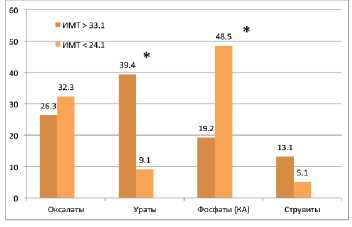
Рис. 1. Основные типы мочевых камней у пациентов с высоким и низким ИМТ.
* р <0,00001. Фосфаты (КА) – фосфатные камни из карбонатапатита
Для понимания изменения характера литогенеза под влиянием увеличения массы тела определяли среднее содержание каждого минерального компонента в камнях пациентов с высоким и низким ИМТ. Это позволяло определить тенденции, ведущие к накоплению или уменьшению в камнях доли минерала определенного типа (табл. 3).
У пациентов обеих групп в камнях, где выявлялся оксалат кальция, более половины минерального состава приходилось на долю этого минерального компонента, который был представлен, главным образом, вевеллитом. Однако, по содержанию оксалатов и их компонентов (вевеллита или веделлита) состав группы оксалатных камней стати- стически значимо не отличался у больных МКБ с высоким или низким ИМТ (табл. 3).
В мочевых камнях с наличием уратного компонента, последний составлял большую часть минеральной фазы камня (82,7-89,6%, табл. 3). При этом, у больных с высоким ИМТ отмечена тенденция к увеличению доли безводной мочевой кислоты (88,05 ± 3,95%), по сравнению с пациентами, имевшими низкий ИМТ (73,00 ± 11,65%, p =0,077).
В то же время доля карбоната-патита в фосфатных камнях у пациентов с ожирением имела тенденцию к снижению (70,00 ± 3,77% до 59,29 ± 5,24%, p =0,065, табл. 3).
Высокий ИМТ сопровождался значительным (в 1,8 раза) повышением в камнях содержания струвита ( p =0,030). Струвитные камни относятся к так называемым «инфекционным» кальциевым камням, которые образуются при инфицировании мочевых путей уреазопродуцирующей флорой [26]. Отмечено, что ожирение может способствовать развитию инфекции мочевых путей [27-29] и, тем самым, создавать условия для формирования струвитных камней. Однако этот вопрос требует дальнейшего изучения, поскольку такая связь не всегда прослеживается [30].
В противоположность этому, в «неинфекционных» кальциевых камнях, то есть в камнях, содержащих кальциевые минеральные фазы с оксалатом и/или карбонатапатитом, суммарная доля этих минералов была достоверно ниже: 93,95 ± 1,84% и 81,33 ± 4,18%, соответственно ( p = 0,016, табл. 3).
Таким образом, результаты указывают, что при ожирении характер литогенеза способен меняться. Это выражается в изменении соотношения минеральных фаз в конкременте: уменьшении доли оксалата кальция с фосфатом кальция и увеличении доли струвитного компонента с тенденцией к накоп- лению в конкрементах доли мочевой кислоты.
Изменения химического состава конкрементов, зависящие от величины ИМТ, более отчетливо проявились при анализе распределения мочевых камней по основным метаболическим типам. В этом случае конкременты классифицировали по преобладающему минеральному компоненту, составляющему более 50% от всей минеральной фазы (рис. 2).
С нарастанием величины ИМТ наблюдали снижение частоты обнаружения у больных фосфатных камней в виде карбонатапатита с 48,5% до 19,2% ( p <0,00001). Однако, вы-явле-ние струвитных камней, имело определенную тенденцию к повышению: c 5,1% до 13,1% ( p = 0,0518).
Частота выявления оксалатного уролитиаза среди больных с высоким и низким ИМТ достоверно не различалась: 32,3 % и 26,3%, соответственно (рис. 2). При этом, доля кальций содержащих камней, представленных оксалатом и/или фосфатом кальция (карбонатапатитом), у пациентов с ожирением составляла 46,5%, то есть, была почти вдвое ниже, чем у больных с низким ИМТ – 82,8% ( p <0,00001).
Показательно, что частота выявления уратных камней у пациентов с ожирением была в 4 раза выше, нежели у пациентов с низким ИМТ: 39,4% и 9,1% соответственно ( p <0,00001). У пациентов с высоким ИМТ наблюдали гиперурикемию и увеличение суточной экскреции мочевой кислоты и фосфатов с мочой, на фоне снижения значений рН мочи.
При избыточном весе, возрастание частоты формирования уратных камней связано с развитием инсулинорезистентности почечных канальцев, что характерно для метаболического синдрома (рис. 3). Ин-сулинорезистентность клеток почечного эпителия приводит к нарушению аммониогенеза. В свою очередь, снижение в эпителиоцитах почки синтеза иона аммония и
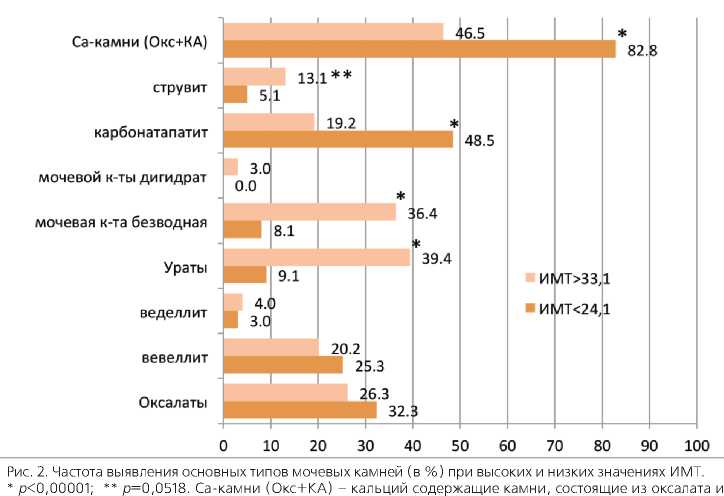
фосфата кальция (карбонатапатита)
Инсулинорезистентность почечных канальцев
| ▼ Почечный аммониогенез
-
V Экскреция иона аммония NH41
I + Свободные ионы Н1 в просвете канальцев I
I #рн мочи |
_____________І________________
-
4 Формирование уратного камня
Рис. 3. Патогенез образования уратных камней у пациентов с метаболическим синдромом по [25].
уменьшение его экскреции в просвет почечных канальцев, снижает обратную реабсорбцию из тубулярной мочи ионов водорода, которые, накапливаясь в просвете канальцев, повышают ацидификацию мочи [25]. Сопутствующая гиперурикурия, по- вышая перенасыщенность мочи, усугубляет ситуацию, являясь фактором
( p =0,077), то различий по этому показателю между женщинами и в
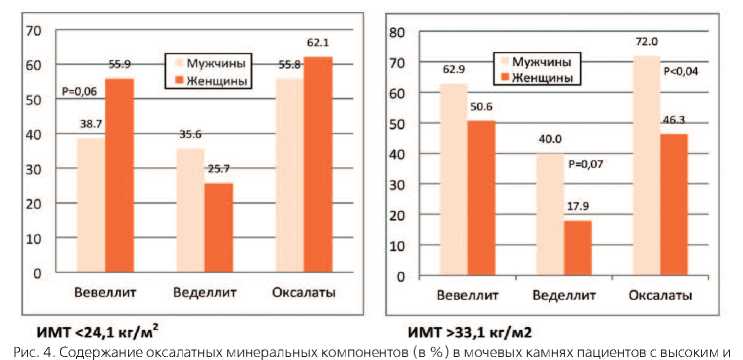
низким ИМТ
инициации уратного литогенеза.
Сравнение пациентов с МКБ по половому признаку показывает достоверное ( p < 0,04) преобладание оксалатов в составе камней у пациентов-мужчин с высоким ИМТ, по сравнению с женщинами, имеющими такие же значения индекса массы тела. В то же время, при низком ИМТ в камнях у женщин, в отличие от мужчин, наблюдали определенную ( p = 0,06) тенденцию к преобладанию доли вевеллитного компонента (рис. 4).
Следует отметить, что если в целом во всей группе больных мужчин и женщин с высоким ИМТ отмечена тенденция к росту содержания в камнях мочевой кислоты
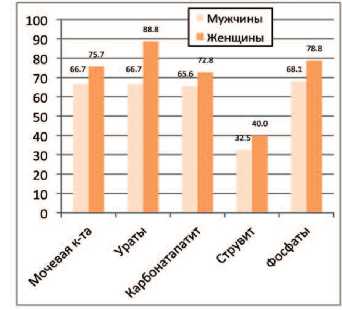
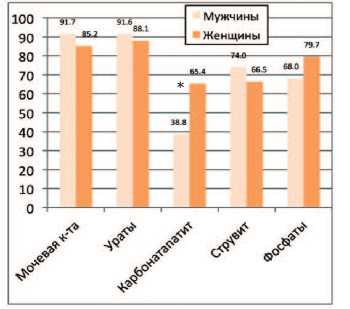
ИМТ <24,1 кг/м1 ИМТ >33,1 кг/м2
Рис. 5. Содержание уратных и фосфатных минеральных компонентов (в %) в мочевых камнях пациентов с низким ИМТ. * р = 0,03
мужчинами выявлено не было (рис. 5). Подобную картину наблюдали и в отношении струвитного компонента, повышенное содержание которого в камнях было характерно для всех тучных пациентов (p=0,03), как мужчин, так и женщин (табл. 3). Различия по содержанию струвита в камнях мужчин и женщин в группах с высоким или низким ИМТ отсутствовали. Тем не менее, у женщин с высоким ИМТ в составе камней содержалось значительно (p=0,03) больше кар-бонатапатита, чем у мужчин (рис. 5).
Было отмечено, что химический состав мочевых камней и, вероятно, сам процесс литогенеза зависят от половой принадлежности пациента [31, 32] Так, у женщин чаще встречается фосфатный уролитиаз, тогда как оксалатные и уратные камни более типичны для мужчин [33]. Можно полагать, что отличия в составе мочевых камней при высоком и низком ИМТ у мужчин и женщин, обусловлены особенностями в патогенезе метаболического синдрома. По-видимому, при ожирении процессы литогенеза у мужчин и женщин протекают по-разному.
Таблица 4. Вероятность формирования мочевых камней различных типов при высоких и низких значениях ИМТ (по значению OR)
|
Мочевые камни |
||||
|
Показатель |
Оксалатные |
Уратные |
Фосфатные (карбонатапатит) |
Струвитные |
|
ИМТ >33,1 кг/м2 |
26 (26.3%) |
39 (39.4%) |
19 (19.2%) |
13 (13.2%) |
|
ИМТ <24,1 кг/м2 |
32 (32.3%) |
9 (9.1%) |
48 (48.5%) |
5 (5.0%) |
|
Отношение шансов (OR) |
0,746 |
6,5 |
0,252 |
2,842 |
|
р |
р = 0,350 |
р < 0,0001 |
р < 0,0001 |
р = 0,056 |
Примечение: Указано число камней каждого выявленного типа. В скобках - % камней каждого типа в 1-м квартиле (n=99) и 4-м квартиле (n=99). Из анализа исключены камни, не выявленные в каком-либо из квартилей (состоящие из дигидрата мочевой кислоты, урата аммония, брушита и цистина)
Так, у мужчин и женщин с избыточным весом отмечается повышенная экскре- ция с мочой уратов и оксалатов, однако, значительное снижение рН мочи выявлено преимущественно у мужчин [34]. При оксалатной форме уролитаза положительная связь ИМТ с экскрецией оксалатов прослеживается только у женщин, а связь ИМТ с экскрецией кальция – только у мужчин [35].
Известно, что мужчины европеоидной расы имеют повышенный риск развития МКБ [36]. Причем, такие проявления метаболического синдрома, как диабет 2 типа и артериальная гипертензия, способны повышать риск развития уролитиаза у мужчин только при наличии ожирения [37]. У мужчин с метаболическим синдромом, наряду с ожирением и ин-сулинорезистентностью, обычно наблюдают симптомы гипогонадизма: снижение уровня тестостерона [38] и гонадотропинов [39]. Отмечено, что у таких мужчин риск развития уролитиаза возрастает почти втрое [40].
Приведенные данные указывают на существование гендерных особенностей литогенеза при ожирении. В то же время, конкретные патогенетические механизмы камнеобразования при ожирении, связанные с полом, мало изучены и требуют дальнейших исследований.
Вероятность формирования мочевых камней различных типов при высоких и низких значениях ИМТ можно оценить по показателю «отношения шансов» (odds ratio, OR), который представляет собой статистический показатель, позволяющий сравнивать силу воздействия факторов риска и оценивать влияние данного фактора риска на две группы лиц. Он рассчитывается как отношение шанса появления события в группе, где фактор действует, к шансу появления события в группе, где фактор не действует.
Результаты показывают, что при высоком ИМТ шансы формирования уратных камней повышаются в 6,5 раз ( p <0,0001), по сравнению с лицами, имеющими низкий ИМТ (табл. 4). Кроме того, пациенты с ожирением имеют достаточно высокий риск ( p <0,056) формирования струвитных камней. В то же время, у лиц с низким ИМТ, по сравнению с тучными людьми, шансы образования фосфатных камней из карбонатапатита достоверно ( p <0,0001) возрастают в 3,96 раза. Что касается оксалатных камней, то вероятность их формирования не зависела от величины ИМТ.
ЗАКЛЮЧЕНИЕ
Таким образом, настоящее исследование продемонстрировало, что у лиц, страдающих ожирением и имеющих ИМТ выше 33,1 кг/м2, значителен риск развития уратных мочевых камней, повышена вероятность формирования струвитных камней, при более редкой склонности к образованию фосфатных камней из карбонатапа-тита. Поэтому нормализацию массы тела у больных МКБ, в первую очередь при уратном нефролитиазе, следует рассматривать в качестве одного из главных и патогенетически обоснованных методов действенной профилактики и метафилактики этого заболевания. □
Резюме:
Исследован минеральный состав 437 мочевых конкрементов от 437 больных мочекаменной болезнью (МКБ) в возрасте от 16 до 75 лет, проходивших обследование и лечение в клинике НИИ урологии Минздрава России. У всех пациентов определяли Индекс массы тела (ИМТ) и биохимические показатели крови и суточной экскреции мочи. Был проведен квартильный анализ данных по величине значений ИМТ. Нижний квартиль распределения был представлен случаями (n=99) со значениями ИМТ (<24,1 кг/м2), а верхний квартиль случаями (n=99) со значениями ИМТ (>33,1 кг/м2).
Список литературы Индекс массы тела и химический состав мочевых камней
- Ramello A., Vitale C., Marangella D. Epidemiology of nephrolithiasis.//J Nephrol. 2000. Vol. 13, Suppl. 3. P. 45-50.
- Robertson W.G., Hughes H. Epidemiology of urinary stone disease in Saudi Arabia.//In: Ryall R., Bais R., Marshall V.R., Rofe A.M., Smith L.H., Walker V.R. (eds) Urolithiasis 2. Plenum Press, New York London, 1994. P.453-455.
- Bartoletti R., Cai T., Mondaini N., Melone F., Travaglini F., Carini M., Rizzo M. Epidemiology and risk factors in urolithiasis.//Urol Int. 2007. Vol. 79, Suppl 1. P.3-7.]
- Romero V., Akpinar H., Assimos D.G. Kidney stones: a global picture of prevalence., incidence., and associated risk factors.//Rev Urol. Vol. 12., N 2-3. P. e86-e96., 2010.
- Заболеваемость населения России в 2003 году: Статистические материалы. М.; 2004 г. (электронная версия МЗ и СР РФ и ЦНИИ организации и информатизации здравоохранения МЗ и СР РФ).
- Заболеваемость населения Российской Федерации в 2013 году: Статистические материалы. М.; 2014г. (электронная версия МЗ РФ и ЦНИИ организации и нформатизации здравоохранения МЗ РФ) Заболеваемость населения Российской Федерации в 2013 году (статистический сборник., 2014 г.); URL:http://mednet.ru/images/stories/files/statistika/zabolevaemost_vsego_naseleniya/2010/zabolevaemost_2014.rar.
- West B., Luke A., Durazo-Arvizu R.A., Cao G., Shoham D., Kramer H. Metabolic syndrome and self-reported history of kidney stones: the National Health and Nutrition Examination Survey (NHANES III) 1988-1994.//Am J Kidney Dis. 2008. Vol. 51, N 5. P. 741-747.
- Antonelli J.A., Maalouf N.M., Pearle M.S., Lotan Y. Use of the National Health and Nutrition Examination Survey to calculate the impact of obesity and diabetes on cost and prevalence of urolithiasis in 2030.//Eur Urol. 2014. Vol. 66, N 4. P. 724-729.
- Wong Y.V., Cook P., Somani B.K. The association of metabolic syndrome and urolithiasis.//Int J Endocrinol. 2015;2015:Article ID 570674., 9 pages. Epub 2015 Mar 22 DOI: 10.1155/2015/570674
- Domingos F., Serra A. Metabolic syndrome: a multifaceted risk factor for kidney stones. // Scand J Urol. 2014. Vol. 48, N 5. P. 414-419.
- Grundy S.M., Brewer H.B. Jr., Cleeman J.I., Smith S.C. Jr., Lenfant C. Definition of metabolic syndrome: report of the National Heart, Lung, and Blood Institute. American Heart Association conference on scientific issues related to definition. // Circulation. 2004. Vol. 109, N 3. P. 433-438.
- Scales C.D. Jr., Smith A.C., Hanley J.M., Saigal C.S. Prevalence of kidney stones in the United States. // Eur Urol. 2012. Vol. 62, N 1. P. 160-165.
- World Health Organization. Obesity and overweight Fact sheet № 311., Updated January 2015., Geneva., Switzerland/URL: http://www.who.int/mediacentre/factsheets/fs311/en/.
- http://www.who.int/gho/ncd/risk_factors/overweight/en/
- World Health Organization. Global status report on noncommunicable diseases 2014., Geneva., Switzerland., Publication date: 2014., Number of pages: 298/URL: http://apps.who.int/iris/bit-stream/10665/148114/1/9789241564854_eng.pdf
- World Health Organization. Global Health Observatory Data Repository. Obesity (body mass index >= 30) (age-standardized estimate),Data by country 2014./URL: http://apps.who.int/gho/data/node.mainA900A?lang=en
- WHO. Physical status: the use and interpretation of anthropometry. Report of a WHO Ex-pert Committee. WHO Technical Report Series 854. Geneva: World Health Organization, 1995. 452 p.
- WHO. Obesity: preventing and managing the global epidemic. Report of a WHO Consulta-tion. WHO Technical Report Series 894. Geneva: World Health Organization, 2000. 253 p.
- Cho S.T., Jung S.I., Myung S.C., Kim T.H. Correlation of metabolic syndrome with urinary stone composition. // Int J Urol. 2013. Vol. 20., N 2. P. 208-213.
- Lee J.M., Kim H.C., Cho H.M., Oh S.M., Choi D.P., Suh I. Association Between Serum Uric Acid Level and Metabolic Syndrome. // J Prev Med Public Health. 2012. Vol. 45, N 3. P. 181-187.
- Lee Y.J., Cho S., Kim S.R. A possible role of serum uric acid as a marker of metabolic syndrome.//Intern Med J. 2014. Vol. 44, N 12a. P. 1210-1216.
- Nejatinamini S., Ataie-Jafari A., Qorbani M., Nikoohemat S., Kelishadi R., Asayesh H., Hosseini S. Association between serum uric acid level and metabolic syndrome components.//J Diabetes Metab Disord. 2015 Sep 14; eCofiection 2015.Gg DOI: 10.1186/s40200-015-0200-z
- Rendina D., De Filippo G., De Pascale F., Zampa G., Muscariello R., De Palma D., Ippolito R., Strazzullo P. The changing profile of patients with calcium nephrolithiasis and the ascendancy of overweight and obesity: a comparison of two patient series observed 25 years apart.//Nephrol Dial Transplant. 2013. Vol. 28, Suppl. 4. P. 146-151.
- Siener R., Glatz S., Nicolay C., Hesse A. The role of overweight and obesity in calcium oxalate stone formation. // Obes Res. 2004. Vol. 12, N 1. P. 106-113.
- Taylor E.N., Curhan G.C. Body size and 24-hour urine composition. // Am J Kidney Dis. 2006. Vol. 48, N 6. P. 905-915.
- Sakhaee K., Maalouf N.M. Metabolic syndrome and uric acid nephrolithiasis. // Semin Nephrol. 2008. Vol. 28., N 2. P. 174-180.
- Eisner B.H., Deshmukh S.M., Lange D. Struvite Stones.//In: Grasso M., Goldfarb D.S. (eds) Urinary stones: medical and surgical management. Wiley., New York., 2014. P. 48-56.
- Saliba W., Barnett-Griness O., Rennert G. The association between obesity and urinary tract infection. //Eur J Intern Med. 2013. Vol. 24., N 2. P. 127-131.
- Semins M.J., Shore A.D., Makary M.A., Weiner J., Matlaga B.R. The impact of obesity on urinary tract infection risk. // Urology. 2012. Vol. 79., N 2. P. 266-269.
- Ribera M.C., Pascual R., Orozco D., Pérez Barba C., Pedrera V., Gil V. Incidence and risk factors associated with urinary tract infection in diabetic patients with and without asymptomatic bacteriuria. // Eur J Clin Microbiol Infect Dis. 2006. Vol. 25, N 6. P. 389-393.
- Nassaji M., Ghorbani R., Tamadon M.R., Bitaraf M. Association between body mass index and urinary tract infection in adult patients. // Nephrourol Mon. 2014. Vol. 7, N 1. P. e22712.
- Parks J.H., Worcester E.M., Coe F.L., Evan A.P., Lingeman J.E. Clinical implications of abundant calcium phosphate in routinely analyzed kidney stones. // Kidney Int. 2004. Vol. 66, N 2. P. 777-785.
- Moses R., Pais V.M. Jr., Ursiny M., Prien E.L. Jr., Miller N., Eisner B.H. Changes in stone composition over two decades: evaluation of over 10.000 stone analyses. // Urolithiasis. 2015. Vol. 43, N 2. P. 135-139.
- Голованов С.А., Сивков А.В., Анохин Н.В., Дрожжева В.В. Тенденции распространенности метаболических типов мочекаменной болезни в Московском регионе. Сравнительный анализ за период с 2010 по 2013 гг. // Экспериментальная и клиническая урология. 2014. N 4. C.54-58.
- Negri A.L., Spivacow F.R., Del Valle E.E., Forrester M., Rosende G., Pinduli I. Role of over-weight and obesity on the urinary excretion of promoters and inhibitors of stone formation-in stone formers. // Urol Res. 2008. Vol. 36, N 6. P. 303-307.
- Taylor E.N., Curhan G.C. Body size and 24-hour urine composition. // Am J Kidney Dis. 2006. Vol. 48, N 6. P. 905-915.
- Stamatelou K.K., Francis M.E., Jones C.A., Nyberg L.M., Curhan G.C. Time trends in reported prevalence of kidney stones in the United States: 1976-1994.//Kidney Int. 2003. Vol. 63, N 5. P. 1817-1823.
- Nowfar S., Palazzi-Churas K., Chang D.C., Sur R.L. The relationship of obesity and gender prevalence changes in United States inpatient nephrolithiasis. // Urology. 2011. Vol. 78, N 5. P. 1029-1033.
- Zumoff B., Strain G.W., Miller L.K., Rosner W., Senie R., Seres D.S., Rosenfeld R.S. Plasma free and nonsex-hormone-binding-globulin-bound testosterone are decreased in obese men in proportion to their degree of obesity. // J Clin Endocrinol Metab. 1990. Vol. 71., N 4. P. 929-931.
- Giagulli V.A., Kaufman J.M., Vermeulen A. Pathogenesis of the decreased androgen levels in obese men. // J Clin Endocrinol Metab. 1994. Vol. 79., N 4. P. 997-1000
- Otunctemur A., Ozbek E., Cakir S.S., Dursun M., Polat E.C., Ozcan L., Besiroglu H. Urolithiasis is associated with low serum testosterone levels in men. // Arch Ital Urol Androl. 2015. Vol. 87, N 1. P. 83-86.

